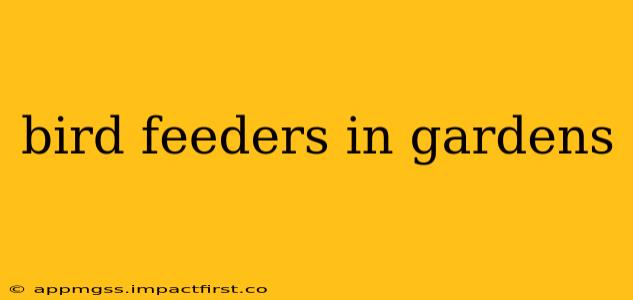Bringing birds to your garden is a delightful way to enhance its beauty and biodiversity. Bird feeders offer a simple yet effective method to achieve this, transforming your outdoor space into a vibrant avian sanctuary. This guide explores everything you need to know about selecting, placing, and maintaining bird feeders to maximize their effectiveness and enjoyment.
What are the benefits of having bird feeders in my garden?
Beyond the sheer pleasure of watching birds, bird feeders offer a multitude of benefits. They provide a supplemental food source, crucial during harsh weather or breeding seasons when natural food sources may be scarce. This can help support local bird populations and increase biodiversity in your garden. Furthermore, birds play a vital role in pest control, consuming insects and other invertebrates that might otherwise damage your plants. The charming sounds and vibrant colors of birds add a lively and engaging dimension to your garden, enriching your overall outdoor experience.
What types of bird feeders are available?
The market offers a wide variety of bird feeders, each with its own design and advantages. Understanding these differences will help you choose the best option for your needs and the types of birds you wish to attract.
Tube Feeders:
These are popular choices, typically featuring multiple feeding ports and a protective cage to deter larger birds or squirrels. They are often filled with seeds or suet.
Hopper Feeders:
Hopper feeders offer larger capacity, often featuring a tray or platform at the base. These are suitable for a wider variety of bird species and can accommodate different types of food.
Platform Feeders:
Simple and open, platform feeders are ideal for birds that prefer to feed on the ground or from an open surface. However, they are also more susceptible to spillage and predation by larger animals.
Suet Feeders:
These feeders are specifically designed to hold suet cakes or blocks, a high-energy food source particularly appealing to woodpeckers and other insect-eating birds.
What types of birdseed should I use?
The type of birdseed you choose directly influences which birds you attract. Black oil sunflower seeds are a popular and versatile choice, appealing to many species. Nyjer (thistle) seeds are a favorite of finches, while shelled peanuts are attractive to jays and woodpeckers. Avoid using cheap mixes containing fillers, which birds may not eat. Consider offering a variety of seeds to attract a wider range of bird species.
Where is the best place to put a bird feeder in my garden?
Strategic placement of your bird feeder is crucial for maximizing its effectiveness and ensuring the safety of the birds.
Placement for Safety:
Position your feeder away from shrubs and trees that could provide cover for predators like cats. Ideally, place it at least 4-5 feet from any potential hiding places. Ensure it's also protected from harsh weather conditions.
Visibility for Viewing:
Locate the feeder where it's easily visible from your windows or other observation points. This allows for optimal enjoyment of your feathered guests.
Accessibility for Birds:
Choose a location free from obstacles that could hinder bird access. Consider the surrounding vegetation and its potential impact on bird approach paths.
How often should I clean my bird feeder?
Regular cleaning of your bird feeder is essential for maintaining its hygiene and preventing the spread of disease among birds. Clean your feeder at least once a month, or more frequently during warm, humid weather. Use a mild solution of soap and water, rinsing thoroughly before refilling.
What if I have squirrels stealing from my bird feeder?
Squirrels are notorious for their ability to raid bird feeders. To deter them, consider purchasing a squirrel-resistant feeder with baffles or cages that prevent access. Alternatively, you can strategically place the feeder in a location less accessible to squirrels, like hanging it from a sturdy branch high off the ground.
How can I attract specific types of birds to my garden?
Attracting specific bird species involves understanding their dietary preferences and providing suitable food and habitat. Research the types of birds you'd like to attract and tailor your feeder choices and seed selection accordingly. For example, providing suet will attract woodpeckers, while offering nyjer seed will draw in finches. Planting native shrubs and trees that provide berries and shelter will further enhance your efforts.
By following these guidelines, you can transform your garden into a thriving avian haven, bringing joy, beauty, and biodiversity to your outdoor space. Remember, responsible bird feeding involves providing clean food, safe placement, and regular maintenance for the well-being of your feathered visitors.
